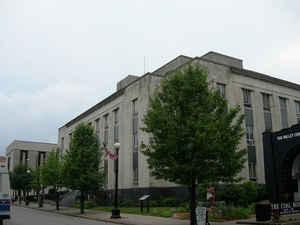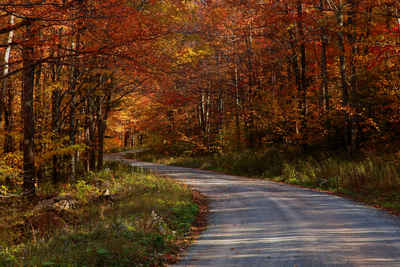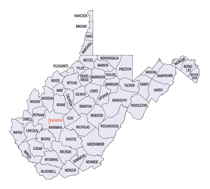West Virginia Counties
There are fifty-five counties in the state of West Virginia. Fifty of them existed at the time of the Wheeling Convention in 1861, before which West Virginia was part of the state of Virginia. The remaining five (Grant, Mineral, Lincoln, Summers and Mingo) were formed within the state after its admission to the United States on June 20, 1863. At that time, Berkeley County and Jefferson County, the two easternmost counties of West Virginia, refused to recognize their inclusion in the state. In March 1866, the US Congress passed a joint mandate assenting to their inclusion.Mingo County, West Virginia
Mingo County Education, Geography, and History

Mingo County is a county located in the state of West Virginia. Based on the 2010 census, the population was 26,839. Its county seat is Williamson. Created in 1895, Mingo is West Virginia's newest county, named for the historic Iroquoian Mingo people.
Etymology - Origin of Mingo County Name
For the Indian tribe of which Logan was chief
Demographics:
County QuickFacts: CensusBureau Quick Facts
Early History of Mingo County, West Virginia
Mingo County is the youngest county in the state, formed by an act of the state legislature in 1895 from parts of Logan County. Its founding was related to a legal protest by a moonshiner who claimed that the Logan County Court that had found him guilty did not have jurisdiction over his case because his still was actually located in Lincoln County. A land survey was taken and discovered that the defendant was correct. The charges were then refilled in Lincoln County court. Although the moonshiner was ultimately found guilty of his crime, the state legislature was made aware of the situation and determined that Logan County was too large for the expeditious administration of justice and decided to create a new county, called Mingo. The county was named in honor of the Mingo Indian tribe that had been the earliest known settlers of the region.
Logan, the most famous of the Mingo Indian chiefs (see Logan County history for more details), was considered friendly and cooperative by most settlers in the region, until his family was massacred on April 30, 1774 in the Northern Panhandle. Several versions of the massacre circulated on the frontier. Lord Dunmore blamed a settler named Daniel Greathouse while Logan, called Tah-gah-jute by his people, blamed Michael Cresap, a Maryland soldier and land speculator who was building cabins along the Ohio River as a means of securing land. Following the massacre, Logan allied his tribe with the British and went on the warpath, leading four deadly raids on the Virginia and Pennsylvania frontiers. These raids were the first battles in what would become known as Lord Dunmore's War and the decisive Battle of Point Pleasant (see Lewis County history).
Williamson, the county seat, was incorporated in 1892. Most historians believe that Williamson was named in honor of Wallace J. Williamson. He owned the land where Williamson now stands, had earned a fortune in real estate investments in the area, and founded the city's first bank and its first hotel. Others claim that the city was named for Wallace's father, Benjamin F. Williamson. He owned most of the land in the region before dividing it among his sons.
Williamson grew rapidly once the railroad connected into the town. Its population, just 688 in 1900, jumped to 6,819 in 1920 and 9,410 in 1930.
The famous Hatfield-McCoy family feud covered a wide area in southwestern West Virginia, including the present site of Mingo County, and parts of eastern Kentucky.
The Hatfields, who lived on both sides of the border and supported the Confederates during the Civil War, and the McCoys, who lived in Kentucky and supported the Union during the Civil War, were never friendly toward one another, but tensions reached a high pitch in 1881 when the two families contested the ownership of a prized razorback hog that had been allowed to run wild in the woods. A Kentucky jury awarded the hog to the Hatfields. Soon afterwards, one of the trial's witnesses, a Hatfield, was found shot to death. The Hatfields accused two sons of Randolph McCloy, the clan's leader, of the crime. A jury later acquitted the two men, but the hard feelings between the two clans soon boiled over into violence.
On August 7, 1882 in Ransom, Kentucky, an election day, Tolbert McCoy, another of Randolph's sons, confronted Ellison Hatfield. Ellison had been involved in the dispute over the hog. The men argued and Tolbert pulled out a knife and stabbed Ellison. Tolbert's two brothers, Randal and Wayne, then joined the fight which ended when one of the McCoy brothers shot Ellison Hatfield in the back. The McCoy brothers then fled. Ellison was carried across the border, where he lingered on death's door for two days before dying. In the meantime, Ellison's three older brothers, Valentine, Anderson "Anse", and Elias Hatfield, captured the three McCoy brothers and brought them back to West Virginia, informing them that if Ellison died that they would be killed. When Ellison died, the three McCoy brothers were taken across the river to Kentucky, tied to some bushes and shot to death. It was assumed that the killings were either done or ordered by "Devil" Anse Hatfield. The feud was seemingly over, except for some minor fights, until the summer of 1887 when a new governor in Kentucky requested that West Virginia extradite Anse Hatfield to Kentucky to be tried for the murder of the McCoy brothers.
When West Virginia refused, Frank Phillips, a Pike County, Kentucky deputy, acting on his own authority, began slipping over the border and forcibly taking various members of the Hatfield clan into custody for various offenses against the McCoy clan. The feud escalated on January 1, 1888, when members of the Hatfield family burnt the home of Randolph McCoy to the ground with Randolph and his family still inside. As they attempted their escape Randolph's wife was seriously injured, and two of his children, a son and a daughter, were killed. Two weeks later, Phillips men crossed over into West Virginia and killed Jim Vance, Anse Hatfield's brother-in-law. Then, on January 19, 1888, a posse, formed in Logan County and comprised of members of the Hatfield clan and friends, had a shoot-out with Phillip's men. The shoot-out attracted national attention to the feud, primarily because it seemingly reflected a growing animosity between the two states that could erupt into a miniature Civil War. A number of additional murders involving the two clans took place over the next several years before the feud finally ended.
Geography: Land and Water
As reported by the Census Bureau, the county has a total area of 424 square miles (1,100 km2), of which 423 square miles (1,100 km2) is land and 0.9 square miles (2.3 km2) (0.2%) is water
Neighboring Counties
Bordering counties are as follows:
- North: Lincoln County
- Northeast: Logan County
- Northwest: Wayne County
- South: Buchanan County, Va.
- Southeast: Wyoming County; McDowell County
- Southwest: Pike County, Ky.
- West: Martin County, Ky.
Education







